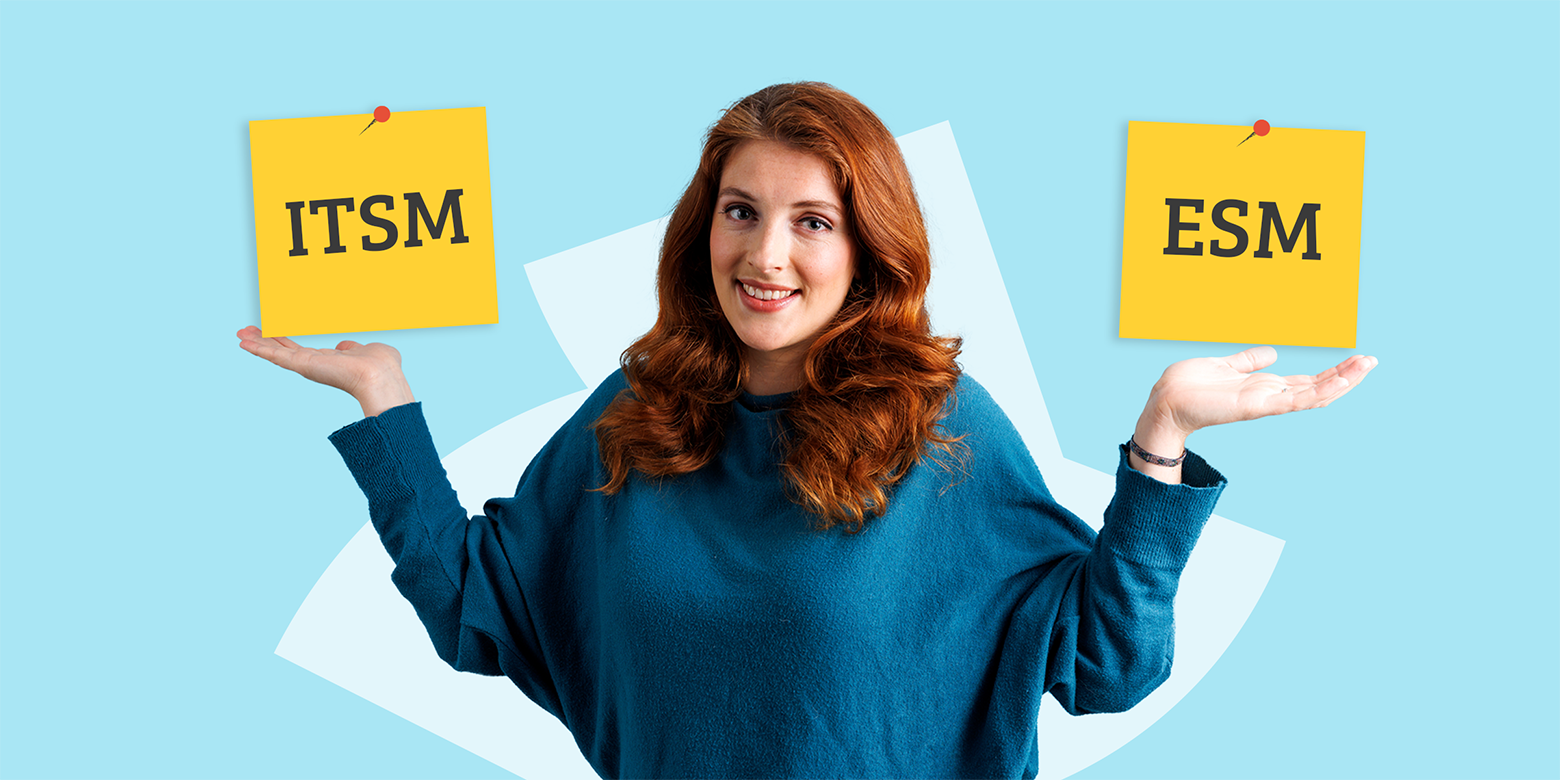ITSM vs ESM: How to know which is right for your organization

Are you looking to find ways to give your IT colleagues that warm, fuzzy feeling? Lots of things are outside your control, but one thing you can control is the smooth-running of your IT Service Management (ITSM) operation. Get this running hiccup-free, blending the right mix of technology and process, and you’ll be enabling everybody to do their jobs without any constraints.
So that’s your IT team happy, but what about the other teams that deliver internal services? Your company relies on HR, Facilities Management, Business Operations teams and more to ensure smooth, daily functioning. Is it the well-oiled machine that it could be? If you answered no, your company might benefit from an Enterprise Service Management (ESM) solution. So when it comes to ITSM vs ESM, where should you start?
What is ITSM?
ITSM is the name you give to the strategy companies have in place to manage the processes and tools required to make IT teams’ lives that bit more straightforward.
Your ITSM strategy likely consists of your IT team’s go-to approach for managing service requests, fixing issues, and keeping customers happy. What makes ITSM great? It boosts efficiency, minimizes downtime, and creates a smoother, more satisfying experience for everyone involved. Beyond streamlining IT support, ITSM enables IT service automation, reducing manual workloads and improving response times. This ensures IT teams can handle requests efficiently, leading to faster issue resolution.
ITSM software then takes your ITSM strategy to great heights by digitizing and consolidating everything. This benefits both users and end users by helping to make identifying and resolving issues easy. They come in all shapes and sizes, including: IT email ticketing systems, knowledge management platforms, and ITSM-enabling tools like TOPdesk or Jira Service Management.
Fundamentally, these tools help connect your whole organization to your IT team in a digitally enabled, process-driven manner, helping you realize your ITSM strategy. By using one, you give your company peace of mind, and your IT function a centralized place to manage their work. To learn more about ITSM, feel free to check out our glossary page where you can find out a lot more.
What is ESM?
Frequently, requests from your end users need to go to a department other than IT. When this happens, this is where having an ESM strategy really helps. In situations like these, ESM tools will help your end users to register requests and questions, regardless of which department needs to act upon them. Similarly, all service department employees work in these tools, too, combining all processes and information. For a deep dive on ESM, have a look at our full guide to Enterprise Service Management.
Ultimately, ESM builds on the solid foundations of ITSM and takes it to the next level by extending its principles beyond IT to your wider business. With a solid ESM strategy, you can bring the same streamlined processes and best practices to teams like HR, Facilities, and Customer Support, making collaboration across departments smoother than ever.
What sets ESM apart? It’s all about reaching beyond IT to bring service management to the entire organization. ESM helps align service management with big-picture business goals, drives digital transformation, and makes everything run more efficiently across the board. This means that everybody’s contributions go recognized and rewarded, ensuring your colleagues feel motivated to work collaboratively to solve problems.
ITSM vs ESM: Key differences and comparison
When evaluating ITSM vs ESM software, it's essential to understand their core differences. ITSM software is designed to optimize IT service delivery, while ESM software extends these capabilities across the entire business, supporting departments like HR and Facilities.
Hopefully it should now be clear that ESM is essentially a way to bottle the magic of ITSM, extending it to other parts of your organization. Here’s a lovely table to illustrate the point:
| Category | ITSM | ESM |
|---|---|---|
| Scope | Focused on IT services. | Enterprise-wide service management, including non-IT departments. |
| Tools and processes | Uses IT-specific tools like service desks and incident management systems. | Builds on ITSM tools, adding cross-departmental functionalities. |
| Business impact | Improves IT service delivery and customer satisfaction. | Drives organizational efficiency and aligns service management with long-term business goals. |
Business value of ITSM and ESM
Okay, so you’re fully familiar with ITSM’s and ESM’s benefits, and the value of their associated software. So the question is: how do you convince the other key decision-makers in your company that investing in the underlying strategy, processes and tools is really going to add value? It might be intuitive to you, but if you’re going to build an ITSM or ESM business case in order to convince all the relevant stakeholders, you’ll need a few gems of wisdom. We’ve got you covered:
Run smoother operations: Integrated service delivery keeps everything efficient and on track, alleviating the stress-induced headaches of your internal teams.
Make end users happier: Streamline services inside the organization for a better overall experience.
Work better together: Foster teamwork and collaboration with a shared services model that brings everybody together to pull in the same direction.
ITSM and ESM isn’t just about improving processes—it’s about making your entire organization work smarter and happier. Happy employees are 13% more productive (according to this study by Oxford University). It really does pay, therefore, to invest to be employee-centric, and investing in ITSM and ESM is a great way to achieve this.
Curious about the ROI of ITSM & ESM? Try our free ROI calculator.
How to adopt ESM: Practical steps
Already up and running with an ITSM strategy and think that ESM could be the next step along your company’s path? Take it one step at a time: Make small, manageable improvements to keep refining and improving things as you go. Here are three concrete steps you can take toward your goal:
Build on what works: Start with ITSM best practices, like ITIL (Information Technology Infrastructure Library), to lay a strong foundation.
Bring everyone together: Encourage teamwork across departments with a single go-to contact to keep things running smoothly.
Use the right tools: Platforms like TOPdesk can help manage services across the whole organization and bring your strategy to life.
If you’d like some support working through these stages, or want to see how our software can support your ESM goals, check out our personalized demo.
ITSM vs ESM case study: How Flagship Group implemented ESM
We’ve helped plenty of businesses to implement ESM using our ITSM software. A relevant example is Flagship Group, a UK-based housing developer, who—having seen excellent results with using TOPdesk for ITSM—decided to broaden the scope of their partnership with us to ESM. According to Flagship Group’s Nathan Fletcher, IT Support Manager, one of TOPdesk’s key differentiating features is its Self-Service Portal:
There are a lot of systems out there for staff to use so having the Self-Service Portal helps everyone—whether they are confident with technology or not.
Read the full case study to learn how Flagship Group successfully implemented ESM using TOPdesk, and to see what results they were able to achieve.
ITSM vs ESM: Choosing the right strategy for your business
In this article, we’ve tried to give you a full breakdown of ITSM vs ESM—both as strategies, as well as the software that can make it all happen. We’ve tried to simplify ITSM and ESM for you, explain what they are, what the differences are, and how to work out where to start.
Ready to go a bit deeper on ESM? Download the ESM e-book for 19 pages of expert guidance, including:
- What ESM is
- The biggest advantages of ESM
- How to launch Enterprise Service Management
- Tips for your (digital) ESM workspace
- Utrecht University’s road to ESM
Inspire others, share this blog


